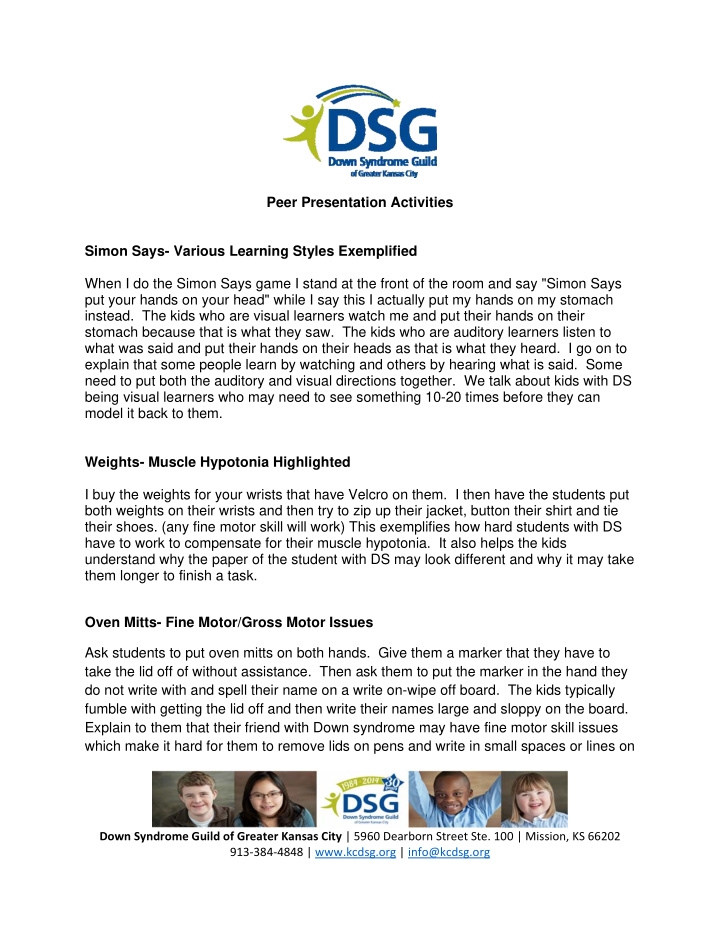



Peer Presentation Activities Simon Says- Various Learning Styles Exemplified When I do the Simon Says game I stand at the front of the room and say "Simon Says put your hands on your head" while I say this I actually put my hands on my stomach instead. The kids who are visual learners watch me and put their hands on their stomach because that is what they saw. The kids who are auditory learners listen to what was said and put their hands on their heads as that is what they heard. I go on to explain that some people learn by watching and others by hearing what is said. Some need to put both the auditory and visual directions together. We talk about kids with DS being visual learners who may need to see something 10-20 times before they can model it back to them. Weights- Muscle Hypotonia Highlighted I buy the weights for your wrists that have Velcro on them. I then have the students put both weights on their wrists and then try to zip up their jacket, button their shirt and tie their shoes. (any fine motor skill will work) This exemplifies how hard students with DS have to work to compensate for their muscle hypotonia. It also helps the kids understand why the paper of the student with DS may look different and why it may take them longer to finish a task. Oven Mitts- Fine Motor/Gross Motor Issues Ask students to put oven mitts on both hands. Give them a marker that they have to take the lid off of without assistance. Then ask them to put the marker in the hand they do not write with and spell their name on a write on-wipe off board. The kids typically fumble with getting the lid off and then write their names large and sloppy on the board. Explain to them that their friend with Down syndrome may have fine motor skill issues which make it hard for them to remove lids on pens and write in small spaces or lines on Down Syndrome Guild of Greater Kansas City | 5960 Dearborn Street Ste. 100 | Mission, KS 66202 913 ‐ 384 ‐ 4848 | www.kcdsg.org | info@kcdsg.org
paper. This is why their paper may look different than yours and why it may take them longer to finish a worksheet. Braille Cards- Accommodations The Braille cards are handed out to kids and we ask them to "read" the cards. They of course cannot do this unless we give them help and show them what the dots mean. We talk about how reading words on paper can be difficult for students with DS so they may need extra help with reading. Students with Down syndrome may have adapted work and a paraprofessional to help them learn better. Marshmallows-Speech Intelligibility Give each student a large marshmallow and ask them to put it on top of their tongue and then turn to their neighbor and say “Hi my name is _______ and my favorite flavor ice cream is __________” While doing this exercise the students will typically giggle and laugh at how funny their words sound. I tell them to chew and swallow the marshmallow or spit it out at that point. Ask the students if it would be frustrating to try to communicate with people and not have them understand you. Then discuss the jaw structure of a person with Down syndrome and how it is smaller and that their tongue may be larger and set back further in their mouth. This causes issues with speech being understood. Suggest ways the students can encourage their friends with Down syndrome to communicate such as: Speak more slowly Can you show me what you are talking about? Can you please say it again? Can you write down what you are trying to tell me? Show students any sign language signs the student uses regularly Encourage the students to respect the processing time of their peers with Down syndrome. Ask them something and wait 10 full seconds before asking another question or giving another prompt. This gives them time to process information and respond. Down Syndrome Guild of Greater Kansas City | 5960 Dearborn Street Ste. 100 | Mission, KS 66202 913 ‐ 384 ‐ 4848 | www.kcdsg.org | info@kcdsg.org
Earmuffs- Hearing Deficits Have students put ear muffs on and then go to a corner in the room that is farthest from where you are presenting. Then give them a 3 step instruction to follow in a hushed voice. The students won’t be able to hear you or follow directions. Encourage them to keep stepping closer until they can hear you. In most cases they will have to be right next to you to hear you and sometimes they still cannot hear you. Explain that many students with Down syndrome have hearing loss. Be sure to speak to your friend with Down syndrome while they are close to you and you are making eye contact with them as that will give you the best chance for successful communication. Down Syndrome Guild of Greater Kansas City | 5960 Dearborn Street Ste. 100 | Mission, KS 66202 913 ‐ 384 ‐ 4848 | www.kcdsg.org | info@kcdsg.org
Recommend
More recommend